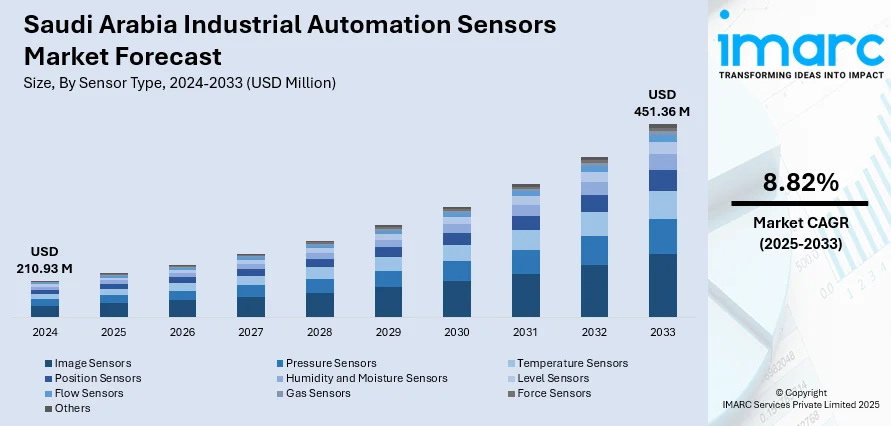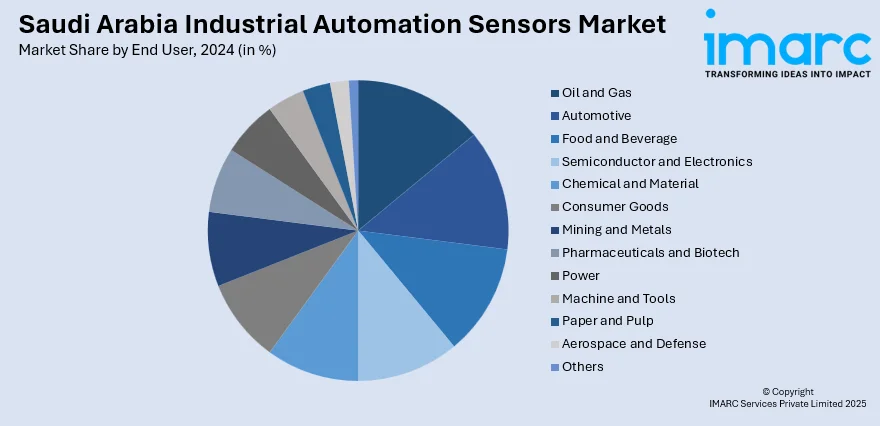
Saudi Arabia Industrial Automation Sensors Market Size, Share, Trends and Forecast by Sensor Type, Type, Mode of Automation, End User, and Region, 2025-2033
Saudi Arabia Industrial Automation Sensors Market Overview:
The Saudi Arabia industrial automation sensors market size reached USD 210.93 Million in 2024. Looking forward, IMARC Group expects the market to reach USD 451.36 Million by 2033, exhibiting a growth rate (CAGR) of 8.82% during 2025-2033. The market is fueled by the growing adoption of Industry 4.0 technologies, government programs such as Vision 2030, and the growing need for operational efficiency across industries. Increasing emphasis on sustainability and energy efficiency, improvements in sensor technology and incorporation of IoT facilitating real-time monitoring, and automation solutions are becoming more appealing and prevalent, which further increases the Saudi Arabia industrial automation sensors market share.
|
Report Attribute
|
Key Statistics
|
|---|---|
|
Base Year
|
2024 |
|
Forecast Years
|
2025-2033
|
|
Historical Years
|
2019-2024
|
| Market Size in 2024 | USD 210.93 Million |
| Market Forecast in 2033 | USD 451.36 Million |
| Market Growth Rate 2025-2033 | 8.82% |
Saudi Arabia Industrial Automation Sensors Market Trends:
Integration of Industry 4.0 and IoT Technologies
The Saudi Arabian industrial automation market is undergoing a radical shift as the nation is embracing Industry 4.0 concepts and Internet of Things (IoT). According to tech giant Ericsson, the Kingdom has an impressive 98% rate of internet penetration among its over 32 million people. As such, firms are combining sensors with IoT platforms to enable real-time data collection, predictive maintenance, and enhanced operating efficiency. By means of this convergence, businesses will be able to make better choices and make their production more streamlined. The Vision 2030 government program is also geared toward supporting this development, diversifying the economy and reducing dependency on oil through technologic growth across various industries. Thus, demand for highly sophisticated sensors that can be easily integrated into IoT systems is on the rise, making Saudi Arabia the industrial automation powerhouse of the Middle East.

Focus on Energy Efficiency and Sustainability
As per international trends, Saudi Arabia is focusing on energy efficiency and sustainability in its industries. Sensors are an essential component for measuring energy consumption, identifying inefficiencies, and meeting environmental standards. Smart sensors, which give real-time data, are being increasingly used in industries, allowing for preventive measures to curb energy usage and prevent wastage. This focus helps in achieving sustainability goals and leads to cost savings and improved operational efficiency. The use of energy-efficient sensors is in line with the overall vision of the kingdom of environmental conservation and economic diversification, while also fueling the Saudi Arabia industrial automation sensors market growth.
Advances in Sensor Technology and Smart Manufacturing
Technological advancement is driving the growth of sensor functionality in industrial automation in Saudi Arabia. Innovations in minuscule, wireless, and energy-harvesting sensors are leading to ever more flexible monitoring. More of these intelligent sensors are being integrated within smart manufacturing systems to increase automation, quality control, and process optimization. Similarly, such technology is used in oil and gas, chemicals, and manufacturing to boost productivity to uphold high levels of safety and quality. Thus, progressive growth in sensor technology is evidence of the willingness of Saudi Arabia to accept cutting-edge solutions in its industrial sectors.
Saudi Arabia Industrial Automation Sensors Market Segmentation:
IMARC Group provides an analysis of the key trends in each segment of the market, along with forecasts at the country and regional levels for 2025-2033. Our report has categorized the market based on sensor type, type, mode of automation, and end user.
Sensor Type Insights:
- Image Sensors
- Pressure Sensors
- Temperature Sensors
- Position Sensors
- Humidity and Moisture Sensors
- Level Sensors
- Flow Sensors
- Gas Sensors
- Force Sensors
- Others
The report has provided a detailed breakup and analysis of the market based on the sensor type. This includes image sensors, pressure sensors, temperature sensors, position sensors, humidity and moisture sensors, level sensors, flow sensors, gas sensors, force sensors, and others.
Type Insights:
- Contact Sensors
- Non-Contact Sensors
- Photonic Sensors
- Hall Effect Sensors
- Capacitive Sensors
- Ultrasonic Sensors
- Inductive Sensors
- Laser Displacement Sensor
A detailed breakup and analysis of the market based on the type has also been provided in the report. This includes contact sensors and non-contact sensors (photonic sensors, hall effect sensors, capacitive sensors, ultrasonic sensors, inductive sensors, and laser displacement sensor).
Mode of Automation Insights:
- Semi-Automatic Systems
- Fully Automatic Systems
A detailed breakup and analysis of the market based on the mode of automation has also been provided in the report. This includes semi-automatic systems and fully automatic systems.
End User Insights:

- Oil and Gas
- Automotive
- Food and Beverage
- Semiconductor and Electronics
- Chemical and Material
- Consumer Goods
- Mining and Metals
- Pharmaceuticals and Biotech
- Power
- Machine and Tools
- Paper and Pulp
- Aerospace and Defense
- Others
The report has provided a detailed breakup and analysis of the market based on the end user. This includes oil and gas, automotive, food and beverage, semiconductor and electronics, chemical and material, consumer goods, mining and metals, pharmaceuticals and biotech, power, machine and tools, paper and pulp, aerospace and defense, and others.
Regional Insights:
- Northern and Central Region
- Western Region
- Eastern Region
- Southern Region
The report has also provided a comprehensive analysis of all the major regional markets, which include Northern and Central Region, Western Region, Eastern Region, and Southern Region.
Competitive Landscape:
The market research report has also provided a comprehensive analysis of the competitive landscape. Competitive analysis such as market structure, key player positioning, top winning strategies, competitive dashboard, and company evaluation quadrant has been covered in the report. Also, detailed profiles of all major companies have been provided.
Saudi Arabia Industrial Automation Sensors Market News:
- In October 2024, as part of its expansion strategy in the Middle East, Emerson, a pioneer in industrial technology and automation worldwide, announced the launch of its advanced manufacturing and innovation hub at King Salman Energy Park (SPARK). The opening of this plant marks the most recent milestone in Emerson's commitment to growing its business in the Kingdom of Saudi Arabia.
Saudi Arabia Industrial Automation Sensors Market Report Coverage:
| Report Features | Details |
|---|---|
| Base Year of the Analysis | 2024 |
| Historical Period | 2019-2024 |
| Forecast Period | 2025-2033 |
| Units | Million USD |
| Scope of the Report | Exploration of Historical Trends and Market Outlook, Industry Catalysts and Challenges, Segment-Wise Historical and Future Market Assessment:
|
| Sensor Types Covered | Image Sensors, Pressure Sensors, Temperature Sensors, Position Sensors, Humidity and Moisture Sensors, Level Sensors, Flow Sensors, Gas Sensors, Force Sensors, Others |
| Types Covered |
|
| Modes of Automation Covered | Semi-Automatic Systems, Fully Automatic Systems |
| End Users Covered | Oil and Gas, Automotive, Food and Beverage, Semiconductor and Electronics, Chemical and Material, Consumer Goods, Mining and Metals, Pharmaceuticals and Biotech, Power, Machine and Tools, Paper and Pulp, Aerospace and Defense, Others |
| Regions Covered | Northern and Central Region, Western Region, Eastern Region, Southern Region |
| Customization Scope | 10% Free Customization |
| Post-Sale Analyst Support | 10-12 Weeks |
| Delivery Format | PDF and Excel through Email (We can also provide the editable version of the report in PPT/Word format on special request) |
Key Questions Answered in This Report:
- How has the Saudi Arabia industrial automation sensors market performed so far and how will it perform in the coming years?
- What is the breakup of the Saudi Arabia industrial automation sensors market on the basis of sensor type?
- What is the breakup of the Saudi Arabia industrial automation sensors market on the basis of type?
- What is the breakup of the Saudi Arabia industrial automation sensors market on the basis of mode of automation?
- What is the breakup of the Saudi Arabia industrial automation sensors market on the basis of end user?
- What is the breakup of the Saudi Arabia industrial automation sensors market on the basis of region?
- What are the various stages in the value chain of the Saudi Arabia industrial automation sensors market?
- What are the key driving factors and challenges in the Saudi Arabia industrial automation sensors market?
- What is the structure of the Saudi Arabia industrial automation sensors market and who are the key players?
- What is the degree of competition in the Saudi Arabia industrial automation sensors market?
Key Benefits for Stakeholders:
- IMARC’s industry report offers a comprehensive quantitative analysis of various market segments, historical and current market trends, market forecasts, and dynamics of the Saudi Arabia industrial automation sensors market from 2019-2033.
- The research report provides the latest information on the market drivers, challenges, and opportunities in the Saudi Arabia industrial automation sensors market.
- Porter's five forces analysis assist stakeholders in assessing the impact of new entrants, competitive rivalry, supplier power, buyer power, and the threat of substitution. It helps stakeholders to analyze the level of competition within the Saudi Arabia industrial automation sensors industry and its attractiveness.
- Competitive landscape allows stakeholders to understand their competitive environment and provides an insight into the current positions of key players in the market.
Need more help?
- Speak to our experienced analysts for insights on the current market scenarios.
- Include additional segments and countries to customize the report as per your requirement.
- Gain an unparalleled competitive advantage in your domain by understanding how to utilize the report and positively impacting your operations and revenue.
- For further assistance, please connect with our analysts.
 Request Customization
Request Customization
 Speak to an Analyst
Speak to an Analyst
 Request Brochure
Request Brochure
 Inquire Before Buying
Inquire Before Buying




.webp)




.webp)












